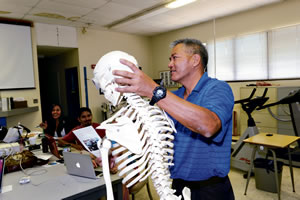Free Concussion Awareness Clinic

Ross Oshiro meets with the HCamp (Hawaii Concussion Awareness and Management Program) committee, showing the location of a facial fracture on a skeleton. Nathalie Walker photo nwalker@midweek.com
Suffering a severe concussion can be a career ender for many athletes. Just ask my dad, who suffered a few concussions in his days playing college football. After the last one, a monstrous hit in the back of the endzone, the team doctor had to practically chase him off the field when my dad showed up for practice the next day, declaring that another concussion might kill him. Dad’s college football days ended right there.
Career-ending concussions can happen in any sport. Jamie Higa was a basketball player at Kalani High School and Chaminade University.
“She’s a former college student-athlete who can no longer continue playing basketball because of multiple concussions,” says Ross Oshiro, who will head up a Concussion Awareness Clinic at the University of Hawaii. “You have to listen to your body because it can have long-term impacts.”
Higa will tell her story as one of the guest speakers at the clinic. Other speakers include Dr. Jennifer King of Kapiolani Orthopedics, and Dr. Benjamin Chun from Kaiser Permanente, plus Oshiro, who serves as the Department of Education Athletic Health Care Coordinator. DOE, UH and Hawaii Athletic Trainers Association are sponsoring the free event that will be held Thursday from 6 to 9 p.m. at the UH-Manoa Athletic Complex Room 242 (across from Stan Sheriff Center).
“This is an important time of year, especially with football starting,” Oshiro says. “We want to get the information out to parents, athletes, coaches, schools and youth sports organizations. It’s important that people understand that trainers will follow a process when a concussion is possible, so it reduces the chances of a second concussion. We also want to educate everyone, especially parents, to know the signs of a concussion.”
Oshiro notes that sometimes athletes have been concussed but don’t know it.
“Signs include a headache, nausea, blurred vision, dis-orientation, balance issues, and they often cannot remember events before and after the hit,” Oshiro says. “The most subtle sign is a simple headache. The brain is trying to work, but it cannot.”
Hawaii has been pretty lucky, Oshiro says, that the state has not seen what he calls “a bad situation. The Mainland has had some deaths and very bad injuries,” he says.
Oshiro, a former baseball player at Saint Louis in the late ’70s, got into working as an athletic trainer after going to college at New Mexico and then getting his master’s degree at UH. For the past 10 years, he’s also helped run Hawaii Optimum Performance, which focuses on making healthy athletes better and helping injured athletes rehabilitate. For the past seven years, he’s been the coordinator who oversees public school athletic trainers.
Athletic trainers on site are young athletes’ first defense in the event of a concussion, but building awareness for all the other people involved in the sport is key.
“Knowing the signs is so important,” Oshiro says.
For more information on how you can attend the Concussion Awareness Clinic at UH, go to doe.k12.hi.us/healthsafety/co ncussions or email coach-esclinic@ahct.k12.hi.us. Or call Ross Oshiro at 203-5515.





